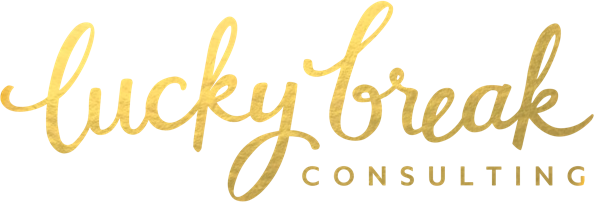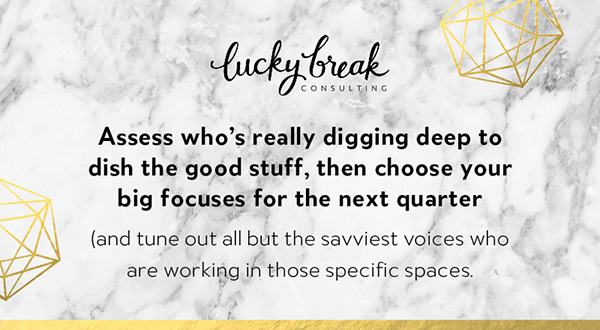Each year, I invite my clients to participate in the Lucky Break client survey. I ask you all sorts of things: about your business, about where you turn for advice, about how confident you feel in various aspects of your business, and about what’s keeping you awake at night.
Several hundred people rose to the occasion this year (thank you!) and I’ve been sharing some of the most common responses. I sifted through hundreds of survey answers to discover that the vast majority of replies fell under one of five main “umbrellas.” In part one of this blog series, I talked about the entrepreneur anxiety that many of us harbor. But that’s not the only thing rumbling across our brain waves at 1am. We have a few other things that lay heavy on our minds… the information that appears as bulleted items below represent verbatim responses from the Lucky Break community.
THE DAILY OVERWHELM OF RUNNING A SMALL BUSINESS
- A “to do” list that’s longer than the time I have in the day.
- Struggling to manage all the facets of my business at the moment… knowing that I’m not able to do it all as well as I need to.
- How to grow my business and not having enough time in the day as a one- person show.
- Making the most of my time.
- I have so many ideas and not enough time to implement them all. If I’m being honest, it’s because I’m trying to do too much myself instead of figuring out how to outsource it.
- I need more bodies, but yikes that costs serious money! So here I sit trying to do it all myself.
- Doing too many things and not finishing them until months later.
Raise your hand if you’ve felt like you’re treading quicksand with your business at some point in the last week? See friend? You’re in good company. I think we all feel that way… and fairly often.
But delegation is the BFF of the the entrepreneur. I understand that it can be terribly difficult, but the good news is that delegation gets easier the more you do it. I have to lock my Inner Control Freak (ICF) in her cage each and every day, but I’ve realized that focus is my friend, and I look terrible in bodysuits + red patent leather boots. I’m no Wonder Woman and I learned long ago to surrender the ideal that I could do it all.
Lost your password to the Lucky Break Virtual Classroom? I won’t be the one replying when you send Team Lucky Break an SOS for a password reset. Looking for a transcript after a Wholesale Matchmaker call? My Operations Manager passes the baton to a third party firm that does it faster and cheaper than we ever could. I outsource the payroll and tax preparation for this business. The graphic design. The coding of my website. I delegate the management of my schedule and the coordination of my speaking engagements.
Why? Because I can’t outsource the curriculum creation or the client calls. Those need me, but not much else at Lucky Break does. By bringing on a team of independent contractors, third-party services, and employees, I can focus on what I do best, what generates the most income, and what delivers the most joy. But delegating that first task can be brutal.
- Play to your strengths. Take out a blank sheet of paper and physically list everything that you do for your company, then rate each task on a scale of 1 to 5 for two factors: How competent do you feel in your abilities? (1 being least + 5 being most competent.) How happy does this task make you? (1 being utterly miserable + 5 being most rapturous joy.) Add those two numbers together and you’ll have a score of 2-10 for each line item.
Scan back through and circle the five tasks with the lowest scores… get those things off your plate ASAP. You’re either not very skilled in them or they’re draining your energy. This is your outsource/delegate list and you can keep picking them off one-by-one as the company grows. Eventually, you’ll retain just the core tasks that you’re fantastically good at really excited about as your daily “to-do” list!
- Utilize technology. Apps are your friend, and we use plenty of them in my businesses to create massive efficiencies. A few of my favorites…
Project Management: to break big projects down into little pieces, set, deadlines, and coordinate moving parts and people. Flying solo? Try Trello. Managing a team? I recommend RedBooth or Asana.
Bookkeeping + Accounting: to track expenses, understand revenue patterns, and understand profitability. Try Wave or QuickBooks.
Payroll: to manage your employee records, dispatch their compensation, and file state + federal taxes. I’ve used Intuit online payroll for more than a decade.
Customer Email Management: to track incoming emails, tighten up your customer support, and quickly answer the most oft-mentioned queries via template responses. The Lucky break team lives and dies by Freshdesk, but I’ve heard good things about Zendesk, too.
Copywriting: to catch my typos, point out the passive voice, and make me look smarter than I am. My on-demand editor of choice is Grammarly.
- Create systems + establish clear protocols. Step one of passing the baton is designing parameters. Create a Content Style Guide to define your brand voice so that you can tag in social media pros, copywriters, and virtual assistants who will interact with your customers. Create a Visual Style Guide to ensure aesthetic consistency as you nudge the graphic design piece off your plate. Document clear, step-by-step systems and you can easily train a helper to take over packaging or shipping on your behalf. If everything lives in your head, then it’s time to get it all down on paper so that you can enlist help and scale the business.
- Remember that focus is your friend. Many of my client’s product collections would benefit from a good trimming. We’re fueled by our passion and the creative facet of product development is deliciously exciting, but this same passion often leads to bloated collections that look like a list of everything we know how to make, rather than a well-curated portfolio of products with a clear point-of-view.
Swollen product ranges keep you running steadily on the Hamster Wheel of Exhaustion, as they simultaneously suck up resources (money, time, physical space, marketing stamina, etc.) and limit overall profitability. Launching and supporting fewer products means you can stretch your marketing dollars further, work fewer hours, and reap higher profits. Three cheers for all of that, right?!? If you’re not sure where to start, then I invite you to explore a blog I wrote about editing a product collection. In short: do less, and do it better.
- Tune in to fewer voices. Free business advice is everywhere, and I suppose that this blog serves as an apt Exhibit A. But the problem is rarely that there’s insufficient food for thought in the business sphere. Thanks to books, blogs, podcasts, conferences, trade networks, Facebook groups, and newsletters, there’s no shortage of food on the buffet. The real problems lies in our propensity to over-indulge. We try to take in too much, then we abandon half-full plates, becoming disgruntled or bored with the work in front of us to return to the buffet to grab yet another full plate of delicacies that will inevitably be picked over and then tossed.
If you’re feeling overwhelmed, try listing each place that you turn to for business advice. Physically writing them all down will likely be an eye-opening experience in and of itself. Look back over that list: Are you a few of those voices duplicative? If so, strike all but the strongest/ wisest/ most supportive. Who invests the majority of their time promo’ing their services as opposed to providing actionable advice? Unsubscribe from their list.
Don’t get me wrong… consultants and coaches have to put food on the table, too. But if their cadence is promo + promo + promo + promo + advice nugget + promo + promo + promo, then you’d likely benefit from tuning out that noise. Assess who’s really digging deep to dish the good stuff, then choose your big focuses for the next quarter (wholesale strategy, product pricing, social media, brand development, marketing, scaling production, etc.) and tune out all but the savviest voices who are working in those specific spaces. Most people discover that culling the buffet makes for calmer head space, lighter inboxes, less overwhelm, and more follow-through on what they do load onto their plate!
And that brings me to another thing keeping us up at night: trying to connect and market to the right people.
CONNECTING WITH YOUR IDEAL CUSTOMER
- Finding the right customer.
- How do we get raving fans and make more money?
- Trying to find the right customers that will build my biz into a profitable venture.
- Right now it’s a lack of sales… needing to dig deeper into my ideal client.
- How to find our right customers where they are, and how to prioritize outreach to the right customers.
- Who the heck is my target market (I have ideas, but I want to know without a doubt).
- Figuring out how to attract customers.
There’s precious little chance of getting traction with your business if you don’t know your people. It’s the equivalent of downing a half-dozen shots, blindfolding yourself in the basement of your neighborhood bar, having a buddy spin you around three times, and then attempting to throw darts at a bulls eye. TLDR: Don’t try this at home.
How can you possibly outwit, outplay, and outlast your competitors when you don’t know who your audience is? Hell, how can you even identify who your competition is if you’re not confident in the identity of your audience? These are not trivial questions for product-based brands. And I’d say better than 95% of all the brands that I work with on their marketing are collecting stray cats for customers by welcoming whomever crosses their paths. But the problem is that in trying to appeal to everyone, we ultimately appeal to no one.
I wish I could dish out a meaty blog that details the process of identifying your target market, but the insight needed and the step-by-step process is far more than detailed than a blog (or even a series of blogs) can convey. But there is a thoughtful process that brand owners can move through to clarify who they want to be marketing to, understand the unifying characteristics and preferences among that group, and then learn to speak their language and identify where they hang out. Ideal customer identification is a core pillar of brand development and a pivotal piece of my Brick House Branding mentorship. This ideal customer worksheet that I created is the beginning of the process, but it’s simply the first step.
If you don’t know who your peeps are, then stop what you’re doing. Pause your ad spend. Freeze your product development. Slow your roll on email marketing and blogs and social media. Go back two spaces and spend some time figuring that out. Because until you do, your business adventure is simply spinning its wheels.









